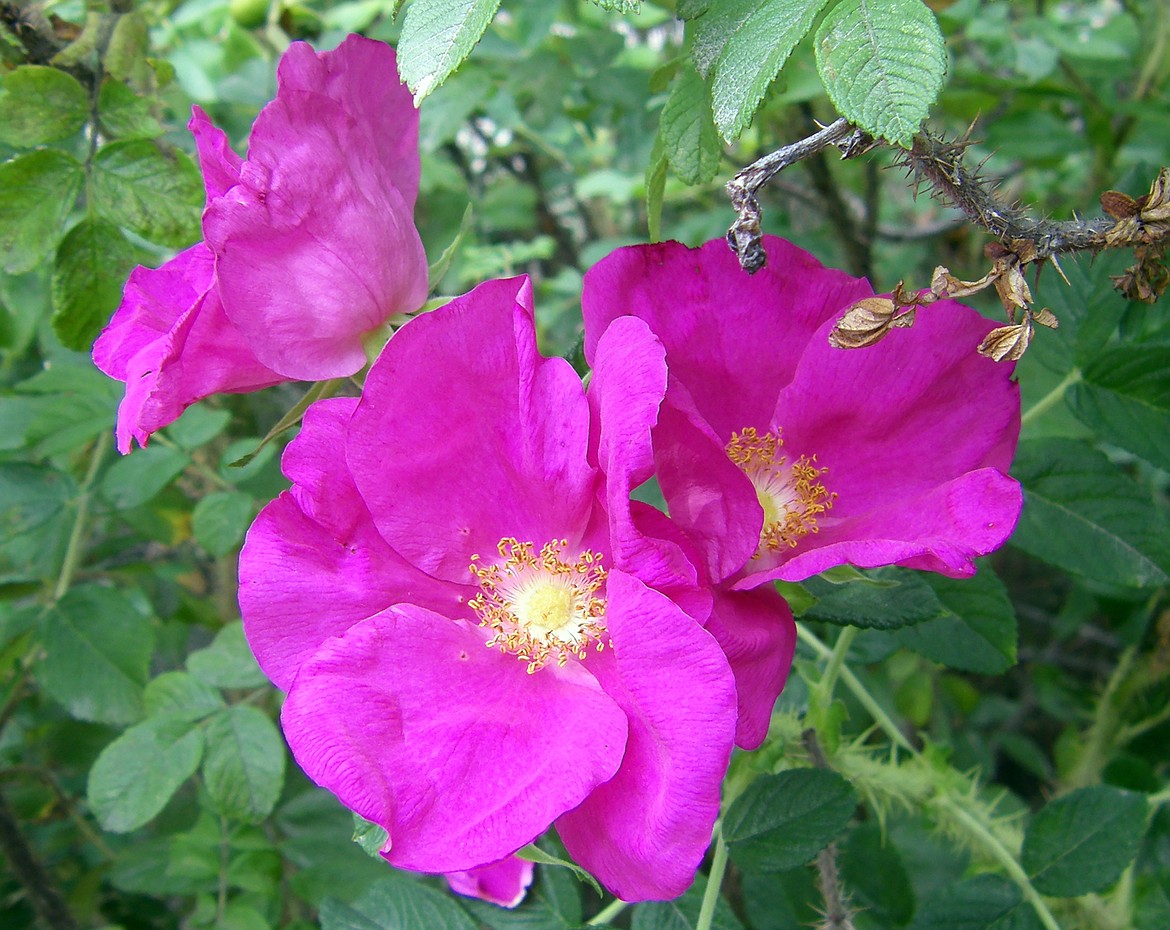Love roses? Choose natives for beauty, scent, hardiness
Whether your roses are arching, rambling, dense, open, upright, climbing, suckering, groundcover, spreading, and in whatever bloom style imaginable, they share one trait: Roses are tough. The daintiest of mini-roses to the huge, glamour-bloomers are inherently hardy and they want to live. Their success at this trait is evident throughout the country – where often one will drive by a deserted old house literally covered in glorious blooms.
There is a caveat, however: “Tough” only goes so far; some roses – the Teas, English or French-style roses are not bred for snowy, icy, windy winters. If you’re planning on putting in some roses, pick what’s right for our area and your space. You can choose from a wide selection of Grandifloras (large flowering), Floribundas (lots of blooms), Shrub (can include many types), Polyantha (many-flowered – the “bouquet” roses), Climbers and Minis. Many area nurseries and greenhouses offer them, and one should definitely buy from them, since they order for our zone and can give you valuable information. Some brand names to look for: Morden; Bucks; Weeks; Carefree; Iceberg; or connotations of Arctic, Canadian Explorer, etc. Remember that “Rugosa” is a native/wild rose and the hardiest one growing. If the family name includes Rugosa in its heritage, it’s just about a sure thing! Please do NOT buy roses from big box stores – no matter how tempting the price; purchase from the pros that sell for our Zone 3-4-5 location.
When planting time comes, be prepared: Spring or Fall, have planting areas prepared planting with compost or aged manure in readiness for your purchased selections. Roses demand a BIG hole and that’s your first and probably most important rule. Own-root roses (the best choice) demand a deep-dug, wide hole that gives plenty of expansion room for roots to spread and take hold. When planting own-roots or your own transplants, line the bottom with well-rotted manure or rich compost, and make a little hill of soil over which to spread the roots. Cover lightly, water well, then fill in the remaining soil.
Potted roses also need a big hole, with plenty of loose soil for their root ball to be planted in. Loosen the compact soil a bit when taking the plant from its pot, and make sure there are no roots circling up and/or around. If there are, cut them away, and make sure the bottom of the root ball is loose enough to enable good contact and merging with the ground soil. You can give a shot of fish emulsion or your favorite (natural) fertilizer, especially if you haven’t used compost in the planting hole. Mulch lightly around the root base and keep watered until nicely established. Twice or three-times a week watering is plenty, and a soaker hose is ideal since overhead watering can cause black-spot and other leaf-spotting problems. Fertilize about every six weeks, stopping at the end of September to allow natural dormancy.
A word of caution: Whether new planting or transplanting - do NOT plant a rose bush in an old rose hole. You must dig out and change the soil completely to make a successful planting in a former site.
Once you’ve planted new roses, do NOT cut them back as some instructions will tell you: That rule is not for our cold-winter climate! Trim damaged branches, then let them be. Too, don’t prune new plants for three years other than for winter-damage, and then only in the spring! (This rule holds for all Perennials – shrub or ornamental; it takes that long for complete root-system establishment).
Finally, remember the one vital caveat for roses: Don’t use pesticides anywhere around them! They are sensitive to all of them, including some of the once-popular fungicides. Use natural repellants and consider Companion Planting (parsley and garlic make great rose protectors/enhancers).
Remember that aphids can be hand- sprayed off with a strong shot of water – do this in the early morning or after sunset so the water won’t spot the petals. Aim the spray low at the stems and necks below the blooms themselves if possible. Hand-pick off curled/damaged leaves and in the spring, keep an eye out for neat rows of butterfly eggs laid on the bottoms of some leaves, leaving them strictly alone.
You may want to try Safer’s Soap if you have bad damage. Some area nurseries carry a wonderful Organic Rose Spray – it’s a nurturing, not-killing product. Partner with Nature’s helpers – the ladybugs, lacewings, bees, butterflies, spiders, ground-beetles, toads and yes, snakes (if you’re lucky enough to have them)! Rose-growing is a “community” effort.
Before the Scotchman Peaks Wilderness group was formed, I had become friends with Top Man Phil Hough when he volunteered with our newly-formed Kinnikinnick Native Plant Society Arboretum crew in the ‘90’s. Too, I’d known Sandy Compton for years before that, so it was kind of a “given” that I would offer to write a monthly column for their newsletter when it began. For several years I enjoyed sharing my knowledge of native plants with member readers, and one of my favorites was the article on Idaho’s wild roses.
Since the columns were designed to be informative and educational, upon a recent re-read of the Wild Rose offering, I realized it could be valuable for Bee readers as well. Big, blowsy imported blooms are indeed beautiful, but a frost, heat wave, dry conditions – etc., can do them in in no time. Not so our wild residents! If you’re considering roses for the upcoming season, here are some good reasons to “go wild.”
Idaho’s native roses, while perhaps not as perfect and elite as their cultivated kin, provide charm and fragrance unparalleled by their loftier progeny. In our area – around June and far into late fall, you’ll find them everywhere – often in the most unlikely places – perhaps ornamenting an aspen grove, accompanying huckleberries in a high peaks patch, or popping out of the mossy boulders on an old rock slide. And while they delight our eyes, they do much more for the wildlife, providing leafy browse for deer and wintertime hips for birds and small mammals (and lost hunters?).
Though you may find several species of roses in your travels through our landscape, only three are considered native to this area; they are the Baldhip rose (Rosa gymnocarpa); Nootka rose (Rosa hispida); and Pearhip or Wood’s rose (Rosa woodsii). A fourth, the Prickly Rose (Rosa acicularis var.) is listed in the Native Plant Society landscaping list as “pink flowers, very spiny”; I am not familiar with this rose.
Each of the first three has special features that make identifying them pretty easy. Probably the easiest is the Baldhip by virtue of its dense armament of straight and soft but thorny prickles on older branches. Leaves are pinnate (feather-like) with 5 to 9 serrated leaflets. The flowers, which bloom from June through July, are small (often only one inch wide) and sweetly fragrant. The hips are orange to red, and small.
The Nootka rose can be spindly or stout, depending on soil and location, so can be found growing from 3 to 7 feet tall. The alternate, pinnate leaves have 5 to 7 leaflets. There are a pair of flattened, straight to slightly curved thorns at the base of each leaf. The flowers are large – from 2 to 3-inches long, pink and solitary at the ends of branches. They bloom from May through July. The fruits are large, round and purple-red.
The Wood’s or Pearhip rose grows from 3 to 7 feet tall, with freely branched stems that can either contain a pair of thorns at the base of each leaf or not. Younger shoots are generally bristly. Leaves are alternate pinnately compound with 5-9 leaflets which are coarsely toothed. The small (1 to 2-inch) flowers are pink and usually borne on branch-ends in few-flowered clusters appearing from May through July. Fruits are dark red and round to oval.
All of the wild roses are considered as beneficial edible and/or of medicinal benefit. The fruits (rose hips) contain more Vitamin C than an orange and the seeds are rich in Vitamin E. They can be eaten raw or stewed, and last through the winter when other fruits are unavailable. Area Native Americans soaked rose petals in rainwater to bathe sore eyes and a tea made from the rose petals was combined with mint for sleep and relaxation. Too, a tea made from the scrubbed rose roots was used for coughs.
A common denominator of all these roses is the alternate, pinnately compound leaf arrangement, the fact that each of the flowers have five petals, and that all of them are hardy from sea level to about 4,500 feet.
All of the roses were utilized and often revered by area Indian tribes. The larger thorns were used for fish lures, buds were often eaten and hips were used in a decoction for an eyewash for sore eyes. A tobacco was made of the dried, powdered leaves and bark, and leaves were often chewed and applied to insect bites to relieve pain and swelling. Some tribes made arrows from the heavier, stronger rose-wood stems. The Salish believe that the Nootka rose offers protection from bad influences and threatening otherworld spirits.
The yellow Harbison’s (or Harrison’s) Rose from southern Idaho is a lovely multi-petaled beauty common around North Idaho for decades, and though not originally native here is, I believe, now accepted as such.
Wild roses are available at several area nurseries, are easily transplanted, and are a boon in your landscape, especially in hedgerows and groupings. I have allowed my plethora of Baldhip roses to take over the front area of my 3/4 acre since nothing else will grow there and they are simply sweet and beautiful. I am also blessed with Pearhips (pictured) and a gorgeous Harrison’s yellow.
The best news is they are care-free. Don’t fertilize them ever; they’re used to lean, acidic soils; and like the pretty country girl in gingham, they’ll outshine the hussies in satin every time.
Valle Novak writes the Country Chef and Weekend Gardener columns for the Daily Bee.



